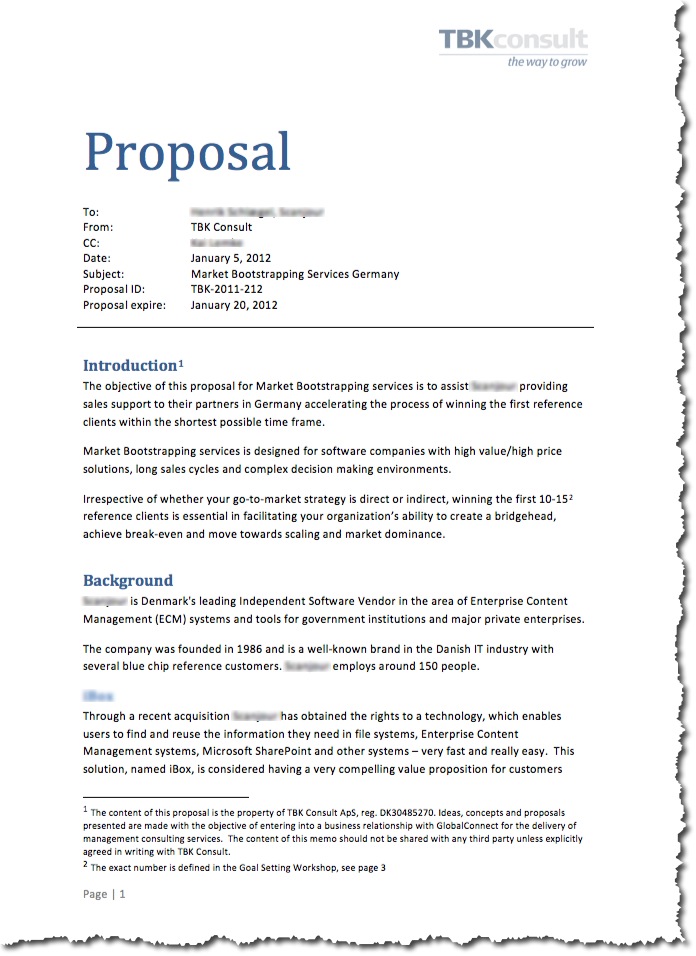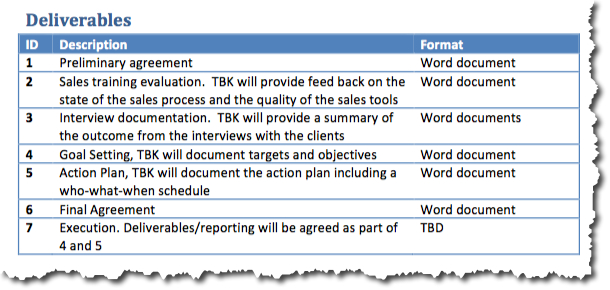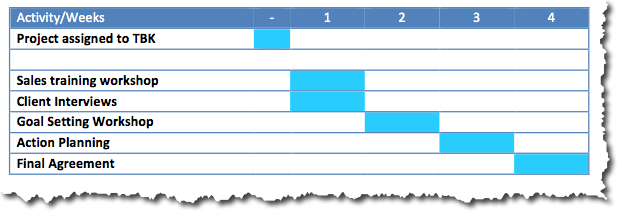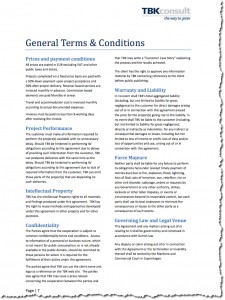
This is the 9th post in a series of posts addressing the issue that too many independent management consultants are working too many hours for too little pay.
See the end of this post for a summary and a list of subjects in the series.
This post is about writing proposals.
The proposal
 The proposal is the written confirmation of what you have agreed with the client during the pre-project discussions including the specific terms and conditions for performing the work. The proposal is also your opportunity to demonstrate that you understand the situation, have identified and qualified the objectives, have defined the specific deliverables, have a clear process for the project and have clear terms and conditions for the payment you will receive for delivering your services.
The proposal is the written confirmation of what you have agreed with the client during the pre-project discussions including the specific terms and conditions for performing the work. The proposal is also your opportunity to demonstrate that you understand the situation, have identified and qualified the objectives, have defined the specific deliverables, have a clear process for the project and have clear terms and conditions for the payment you will receive for delivering your services.
The proposal should as clearly as possible illustrate that the price to be paid for your services is peanuts compared to the business potential released by your contribution.
The content of a management consulting proposal
I recommend using the following structure for your proposal:
- Introduction
- The Background
- The Business Objectives
- The Purpose of the Services Offered
- The Deliverables
- The Process
- Terms & conditions
In the following I will elaborate briefly on each section of the proposal.
Introduction
The introduction is a brief management summary of the purpose of the proposal. What will you do, why will you do it and what are the outcome expected to look like.
The Background
The background is a brief description of the clients business. Normally you can use the “About Us” from the clients web site and sharpen the content with you own words. Most clients have very fluffy and glossy adjective ladden “About Us” statements. Clean out the fluff and present a crisp description of the client’s core activities and their current market position.
Describe the current situation with a focus on the challenges and the opportunities associated with the business environment related to the area where your services are to be delivered. This section describes the clients motivation for investing money in engaging you.
The Business Objectives
A management consulting service is seldom a self contained project; it is mostly a component of a larger context. Describe the business objectives associated with the grand project. Translate the objectives into tangibles if possible. What is at stake if nothing is done? What is gained when the project is successful?
This section of the proposal is the most critical. The probability that you will get this assignment is directly proportional with the size of the business opportunity for the client and your understanding of this relationship.
The purpose of the service offered
In this section you specify the purpose of the service you provide related to the overall business objective. Focus on the outcome of the service in terms of business value.
The Deliverable
 List and specify what you will deliver and in which format. Deliverables are typically:
List and specify what you will deliver and in which format. Deliverables are typically:
- Preparation and facilitation of workshops
- Documentation
- Recommendations
- Meetings
If you know the principle content of reports you can include a table of content or a sample report as an appendix. The more specific you can be on the content and format of your deliverables the better.
The Process
 The process is describing the activities required to produce the deliverables and the associated timeline. As an independent management consultant your typical process steps are:
The process is describing the activities required to produce the deliverables and the associated timeline. As an independent management consultant your typical process steps are:
- Research (existing client documentation and Internet)
- Surveys
- Interviews
- Workshops
- Meetings
 Provide a simple Gantt chart illustrating when you will perform which activities and deliver which deliverables.
Provide a simple Gantt chart illustrating when you will perform which activities and deliver which deliverables.
Don’t be too specific on the process. Leave it as open as possible. Your obligation is to deliver the deliverables. The process is not really important for the client other than he should be convinced that you have one.
Terms and Conditions
In this section you quote your price(s) and the payment schedule for the services to be delivered.
 You may want to submit your first draft of your proposal the the client without prices. Doing so gives you an opportunity to verify the situation, the objectives, the deliverables and the process one final time. In case of adjustments you have the opportunity to apply corresponding adjustments to the price afterwards.
You may want to submit your first draft of your proposal the the client without prices. Doing so gives you an opportunity to verify the situation, the objectives, the deliverables and the process one final time. In case of adjustments you have the opportunity to apply corresponding adjustments to the price afterwards.
I recommend to quote prices separately only on items which are genuinely separate, meaning that they actually can be excluded from the delivery without affecting other deliveries. Bundle items which are interrelated.
Pack as many of your Terms & Conditions as possible into “General Terms & Conditions”. These T&C’s should comply with industry standards and should be non-negotiable.
If your work is depending on client contributions you may want to define the consequences of the client’s lack of performance (which is almost always the case!!).
Next blog post in tho series: Negotiating the price and payment terms.
Increase your prices: Summary
I meet and talk with a lot of independent management consultants. 99% of them are extremely busy. They are so busy that they have little time to learn new approaches, keep up with the development in their area(s) and develop their business. Most of them even complain that they are too busy. They also use their busyness as an “excuse” for not being responsive and not meeting deadlines.
When I ask why they are so busy the unison answer is: “client projects”. My response is: “Fantastic, you must be making tons of money?” Answer: “Silence.”
The silence continues when I ask them: “When will you increase your prices and with how much?”
This series of posts will address the “many hours/low price” issue, explain the causes and provide recommendations for how you can remedy the situation. Applying the ideas should enable you to work less hours, make more money and have more fun at the same time.
Other posts in the series:
Post #1: Brand values and positioning
Post #2: Networking
Post #3: Pre-qualification
Post #4: The first meeting
Post #5: Self assessment
Post #6: The objectives
Post #7: The deliverables
Post #8: Pricing
Post #10: Price and Payment terms
Post #11: Client references
Post #12: Delivery
Post #13: Quest for Certainty

Pingback: Increase your prices - part 10: Negotiating the price and payment terms | Helping companies grow
Pingback: Increase your prices - part 1 | Helping companies grow
Pingback: Increase your prices - part 2 | Helping companies grow
Pingback: Increase your prices - part 4 | Helping companies grow
Pingback: Increase your prices - part 5: Self assessment | Helping companies grow
Pingback: Increase your prices – part 11: Client References | Helping companies grow
Pingback: Increase your prices – part 3: Pre-qualification | Helping companies grow
Pingback: Increase your prices - part 6: The objectives | Helping companies grow
Pingback: Increase your prices - part 7: The deliverables | Helping companies grow
Pingback: Increase your prices - part 8: Pricing | Helping companies grow
Pingback: Increase your prices – part 12: Delivery | Helping companies grow
Pingback: Proposal (20.02.2014) | JIYEA PARK
Pingback: Management Consulting Essentials: Positioning - Hans Peter Bech